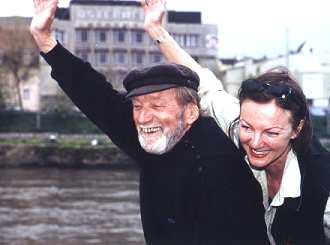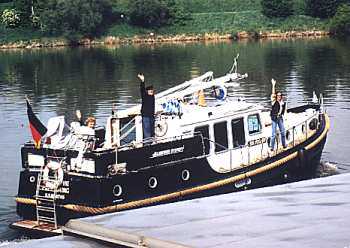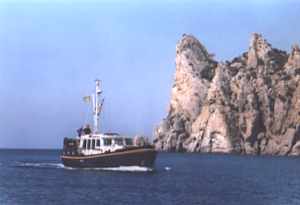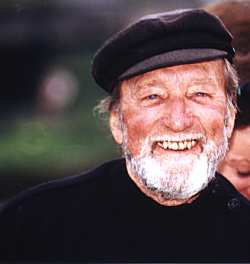Visiting the Black Sea Dolphins with "Solveig VII"
by Rollo Gebhard - translation: Ulrike Kirsch |
|
Together with the BREMA Institute in Simferopol, we prepared a kind of scientific expedition to the Black Sea and the Crimean peninsula to study the overall situation of the dolphins and other marine animals in the Black Sea and assist the Institute in their research. My own boat, "Solveig VII," was to serve as a basis for longer trips. Dr. Alexei Birkun, director of the BREMA Institute, had started working on the plans in 1997 and obtained the required special permits from the government and the military. We started our journey in May 1998 on the Danube. We were a bit worried about the possibly dangerous passage through Serbia. However, we were surprised at the friendly welcome and were able to reach Bulgaria and finally Izmail, Ukraine, without any difficulties. |
 |
Arrival in Ukrainian WatersA first highlight for us was to visit the waters of the northern estuary arm of the Danube, which had been a prohibited area for seventy years, hence practically unknown. In Izmail, the scientists of the BREMA Institute headed by Dr. Alexei Birkun joined us on board and acquainted us with the delta's partly exotic fauna. We watched pink pelicanes, the only ones to live in Europe, and were able to free a cormorant who got caught in a fishernet. Certainly, this was no heroic feat, still, it was a beautiful experience and a good start for our expedition. |
 |
Snake IslandThe next point on the agenda was a visit to "Snake Island." We were the first foreign boat to ever visit this island in the Black sea, which serves as a military base and observation station. There was no protected berth, let alone a harbour. The main purpose of visiting this island was scientific studies on the island, which even scientists had not been allowed to visit up to then. Although we did not see any dolphins, I and my guests, Dr. Alexei Birkun and his assistant, Sergei, were happy to have seen the island and made some biologically important records. |
OdessaNext morning, around 9.00 a.m., we reached the coast near Odessa, and immediately were contacted via radio by the borderguards. From then on, we were under permanent observation. Professor Seizef, head of the biology department of the famous seaport's University, provided us with important information on the present condition of the Black Sea. The internationally recognized scholar was quite positive: "In 1989, the flora and fauna in our waters were in a desperate condition. A few more years of Soviet Union and there would have been no life left in the Black Sea. As a consequence of the economic depression after the fall of the Soviet Union, fishing activities have declined, many boats are out of operation and being scrapped. On the one hand, this is deplorable since many factories in the Ukraine, similar to the ones in former East Germany and in Russia, have turned into ruins, but, on the other, the fish population has recovered to a remarkable extent. I never would have thought that this could happen that fast!" From Odessa our journey led us to the estuary of the Dnjepr, then to Tschernomorskoje and Evpatoria, small ports on the Crimean peninsuala. The CrimeaMeanwhile, scientists from Odessa had joined our team on board. They thus had a chance to visit and study remote nature conservation areas. We still had not seen any dolphins, and the manager of the nature conservation area told us that the water in this area is mostly too shallow for marine mammals. We had a friendly welcome in the first ports we reached on the Crimea. It turned out that our yacht was the first from the West to ever make a journey along the coast of the peninsula. Yet, there were difficulties to overcome, involving hours of waiting: never-ending formalities, constantly reporting on our position, requesting new documents for each stretch from port to port. Our Ukrainian and Russian friends were of big help and finally we were allowed to visit not only Sewastopol, but even some military bases of the Russian Black Sea fleet such as Kertsch and Balaklava, which had previously been strictly secured. |
 |
The DolphinsOn numerous trips along the coast, Alexei Birkun and his assistants had the opportunity to watch dolphins which, alone or in pods, accompanied our boat. Time and coordinates were recorded which will later on provide important information at international conferences. BREMA has become quite famous in Europe for their masterly presented statistics. Thus, BREMA managed to persuade the Ukrainian government to publish a "Red Book" which lists the animal species in need of protection. Thanks to Dr. Birkun, dolphins are part of it. We managed to collect important data on the dolphin populations off the coasts and at sea. Dr. Birkun will report on our joint efforts in a separate study. The scientists were quite amazed at how substantial the dolphin populations still are or are again. Quite often, we were able to watch dolphin pods of up to 50 animals each, which accompanied us sometimes for up to an hour. |
The RisksDr. Birkun did not hesitate to confront us with the daily risks the marine mammals have to face. To enable us to make an in-depth documentation on the killing of dolphins, he obtained a permit from acquainted fishermen for a meeting on the high seas. Many days passed before the circumstances and the weather were right for us to work with our cameras. The Black Sea is not a friendly one, which has to do with the mountains along the coasts. Several times we were hit by a storm which made us uncomfortable or even a bit afraid. Finally, the weather calmed down and the fishermen could go to sea with their small boats. We got ready to set course for the position arranged. After three hours the fisherboats came into sight. When we reached them they started to pull out their gillnets. Three dolphins had drowned in the nets in one day and could only be recovered dead! This was a very sad sight. Still sadder was the fishermen's confession that dolphins died in the nets almost with each catch and boat. This reminded us of Denmark, where numerous harbour porpoises also fall victim to gillnets. Ashore, it is easy to document the damage inflicted upon nature, such as felled trees or killed animals. What a difference at sea! There, fishery pirates can do as they like not having to fear any interference by authorities or environmental activists. Normally, a captain of a trawler will not allow any documentation to be taken on his boat in relation to the killing of dolphins. That's were Dr. Birkun supported us so that we were able to take such important and convincing video footage, showing the threat to dolphins quite clearly even irrespective of the conditions in the Crimean waters. HelpCan these fishing methods be outlawed by new legislation? Given the desperate economic situation in the Ukraine, this will certainly not happen soon. Only BREMA's continued awareness raising activities, in schools in particular, will increase people's sensitivity towards the need of introducing fishing methods which enable dolphins to recognize nets already from a sufficient distance. The months we spent along the Crimean coast definitely contributed to the dolphin's cause and nature conservation, in general. In TV shows and numerous newspaper interviews, we were repeatedly able to point out the necessity of protecting dolphins and emphasize BREMA's excellent efforts. It is of utmost importance that they can continue their work in support of the conservation of the Black Sea fauna and flora. The international relationships Dr. Birkun managed to establish will also allow to carry out bigger projects in future. Our donations allowed the Institute to go on with their work while waiting for the funds promised by Brussels. At Bay, an efficient dolphin clinic will soon start its work. The pool, where dolphins will be temporarily taken care of, is a former swimming pool of a young people's home and is separated from the sea only by a net along its longitudinal side so that there is a permanent supply of fresh water. We also handed over another major sum personally so that they can buy equipment and fuel for the small motorboat which belongs to the "Marine Mammal Rehabilitation Center" and is needed for further observations. Thus, GRD was able to provide important help to BREMA once more and enable the Station to continue their work. Like the motorboat, almost the entire equipment including the workshop, a crane, the filtration unit, and water pipes, originates from the former Russian military equipment and was restored by the employees. It is admirable how they transform objects which would end up in scrap-yards in Europe into equipment which serves a useful purpose. In October, finally, the Solveig VII left our last stop, Kertsch, to set course to Istanbul along the Black sea coast of northern Turkey. |
 Rollo Gebhard |
Turkish WatersDr. Birkun stayed with us to collect data. However, we did not see any dolphins along the Turkish coast. We fear that the marine mammals were pushed to the brink of extinction there even before a ban of catching them had finally come into force. We doubt that this ban is always observed nowadays: In early 1998, the Ukrainian coast guards happened to come across a Turkish trawler carrying more than one hundred dead dolphins. According to yachtsmen, there are hardly any dolphins left along the Turkish coast of the Aegean Sea, either. In spite of these partly very negative experiences, we are sure that our work and the efforts of other organisations will, in the long run, exert so much influence on the public that the senseless killing and torturing of these precious creatures will finally come to an end. Until then, we need to go on. |
Reprinted with the kind permission of:
Gesellschaft zur Rettung der Delphine e.V. (GRD)
Mit "Solveig VII" zu den Delphinen im Schwarzen Meer
|
|||||||||||||||